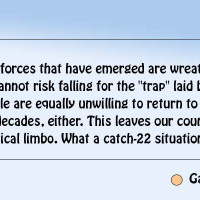- Monday, 12 January 2026
PM Prachanda’s China Visit
Will Expedite Implementation Of Past Deals?
Prime Minister Pushpa Kamal Dahal Prachanda has returned home Saturday after completing his over a week-long visit to China, renewing bilateral bond with the northern neighbour and focusing on the implementation on the past agreements. There was a high expectation that Prachanda’s visit will make some breakthrough in picking vital projects to be executed under the Belt and Road Initiative (BRI). The 13-point joint statement, issued by the two countries, has simply mentioned ‘to finalise the text on the BRI Implementation Plan at an early date.’ The two countries have agreed to construct cross-border transmission line as early as possible, enabling them to enhance cooperation in energy sector.
During Chinese President Xi Jinping’s state visit to Nepal in 2019, Nepal-China relation was elevated to ‘strategic partnership of cooperation featuring ever-lasting friendship for development and prosperity’. At that time, the two nations had signed 18 memorandums of understanding and two letters of exchange. Some important accords are related to the cross-border railway, border management, governance capacity building, investment and economic cooperation. Likewise, in 2016, Nepal and China had entered landmark Transit and Transportation Agreement (TTA), which allowed Nepal to use Chinese ports for the third country trade. The TTA is supposed to turn Nepal from a land-locked to a land-linked country. One year later, the two countries inked a MoU to boost bilateral cooperation under the BRI’s framework.
Political trust
Lack of political and bureaucratic will, COVID-19 pandemic and inimical geopolitical environment have been attributed to slow progress in implementing these deals. When PM Prachanda met with the Chinese President in Hangzhou, the capital city of east China’s Zhejiang Province, the two leaders were said to have candidly discussed the implementation status of the agreements. The real outcomes of Prachanda-Xi parley can be seen only in the future. Building mutual political trust and understanding was the key to deepen the bilateral bond at the government-to-government and people-to-people level. And Prachanda’s visit is believed to have worked in this direction.
Nepal and China have reiterated to ‘exchange experiences on their development strategies, deepen practical cooperation in such fields as infrastructure connectivity, trade, tourism, production capacity and investment, and further deepen and solidify Belt and Road cooperation to deliver greater benefits to their peoples'. For the Trans-Himalayan multi-dimensional connectivity network, the two nations agreed to build ports, roads, railways, airways and grids in an orderly manner. The leaders of two countries are of the view that this connectivity infrastructure will play a catalytic role in realising the development aspirations of Nepalis. They also want to ensure the safety of the cooperation projects and company personnel of the two countries. However, there is the need for defining and clarifying the concept of ‘multidimensional connectivity network’ to make it relevant and meaningful bilateral agenda of two countries.
With the COVID-19 pandemic breakout, the trade checkpoints along Nepal-China border were shut down. This has severely impacted the bilateral trade and people's movements between the two countries. After a long gap, the Lizi-Nechung port and the Zhangmu-Khasa port have opened for passenger services. Likewise, agreement has been made for the smooth operation of passenger and cargo services at Pulan and Jilong ports. There is an understanding to resume the eligible traditional China-Nepal border trade points. These developments have brought cheers to the Nepali traders. In yet another development, the two countries have decided to accelerate the feasibility study of the Tokha-Chhahare Tunnel project that will boost the connectivity between them.
The two countries have expressed satisfaction over the progress of the feasibility study of the Jilong/Keyrung-Kathmandu cross-border railway although there is no breakthrough in the investment modality on the construction of the cross-border railway considered China’s gateway to South Asia, and a viable means for Nepal to secure economic independence. One positive development is China’s readiness to encourage its domestic airlines to resume and operate more flights and air routes to Pokhara International Airport, which was constructed with Chinese funding. Nepal holds huge potential in hydropower development. The agreement to start the construction of the Jilong/Keyrung-Rasuwagadhi-Chilime 220 KV cross-border power transmission line at an early date can boost energy cooperation between the two countries.
Nepal Visit Year
The two neighbours have agreed to declare 2025 as the Nepal Visit Year in China with a view to increasing Chinese tourists in Nepal. This is indeed a praiseworthy initiative to support Nepal's culture and tourism sector as the visit of even a fraction of Chinese tourists to Nepal can give a fillip to its tourism that is still struggling to revive following the devastation of pandemic. Nepal has announced to support China's Global Development Initiative (GDI) and consider joining the Group of Friends of the GDI. China has of late rolled out a number of initiatives pertaining to civilisaiton, security, development and connectivity. China must have felt satisfied after its immediate neighbour decided to back up GDI. However, Nepal has refused to be part of Global Security Initiative (GSI), citing its policy of not joining any security alliance as per non-aligned foreign policy.
Nepal and China are age-old friends. Their bilateral tie is guided by Panchsheel (five principles of peaceful coexistence). China has emerged as a global power economically and militarily. It has made strides in mega-infrastructure development, technological innovation, poverty reduction, trade, investment and clean energy, among others. However, Nepal has not been able to benefit from the economic miracle of northern neighbour when it comes to bringing in the latter's investment, technology and experiences. As a Least Developed Country, Nepal needs the support of its neighbours, friendly nations and international community to end its poverty, boost development works and create jobs. Our political leadership is required to demonstrate aptitude and broader understanding to break external and internal obstacles to muster economic cooperation from the northern neighbour by keeping the nation's balanced foreign policy and core interest intact.
(The writer is Deputy Executive Editor of this daily.)










-(1)-original-thumb.jpg)






